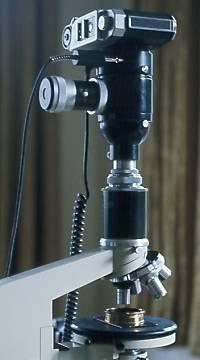
|
Flash Photomicrography.
Electronic Flash as a Light Source for Photography through the Microscope. |
Page 6 of 7 |

|
Flash Photomicrography.
Electronic Flash as a Light Source for Photography through the Microscope. |
Page 6 of 7 |
 The photomicrographic camera shown in the picture on the right is by Zeiss, and is attatched to a Meopta adjustable drawtube having the same circular dovetail as the Biolam microscope to which it is fitted.
The photomicrographic camera shown in the picture on the right is by Zeiss, and is attatched to a Meopta adjustable drawtube having the same circular dovetail as the Biolam microscope to which it is fitted.
The camera body takes 35mm film and has a manual film advance lever. The focusing telescope is coupled to a 70/30 beamsplitter cube, with 70% of the light from the eyepiece going to the film. A major advantage of this type of camera is the Compur blade shutter fitted to the camera body. The shutter speeds range from 1 second to 1/125 second, and the shutter action produces so little vibration that the camera can be directly attatched to the microscope without danger of blurring the image for the low to medium-high powers using continuous light, and for the entire magnification range using flash. The risk of vibration is further reduced by the use of a pneumatic shutter release, actuated by a bulb. The camera requires careful setup before a photographic session to ensure that the image seen in the focusing telescope is exactly parfocal with the image at the film plane. There is a sliding adjuster on the side of the focus telescope for this purpose. A graticule in the telescope eyepiece shows the area which is captured on the film. The pictures below show one way in which a single-lens reflex camera may be adapted to photomicrography. The electronic flash illumination setup is the dual-source Köhler lamp described earlier in this article.
The SLR camera used here is the Nikon F, fitted with a motor drive, an M screen (pure Fresnel, no diffusion) and the DW2 (6 power) magnifying viewfinder. The body is attatched to a bellows having a 125mm achromat at the end closest to the microscope eyepiece, and the bellows extension set so that the achromat gives a focused image of very distant objects. The camera body and bellows is fitted to a Pentax copypod, with one of its four adjustable legs removed to allow easier access to the microscope stage. The legs are located in soft rubber sockets whose position on the baseboard can be adjusted. To take pictures, the binocular head is replaced by the preset Meopta drawtube with appropriate x5 eyepiece, and the camera positioned over the eyepiece by bringing it forward until the third leg locates in its rubber socket. The rear legs are kept located by the action of tensioned springs, and the weight of the camera keeps the whole in alignment. The use of a trinocular head would of course enable the camera to be left in position. The camera is fired by pressing a button on the end of the external battery casing seen at the near edge of the baseboard. Not illustrated here is the often-suggested arrangement of attatching a normal SLR camera body directly to the microscope by means of some kind of adapter. The simplicity of this setup is tempting, and whilst it can be made to work after a fashion for very low-power photomicrographs, it suffers from two major disadvantages. 1. The mechanical action of the camera, especially the movement of the reflex mirror, guarantees that the microscope is in a state of vibration at the moment of exposure. At the higher magnifications, this vibration can be so severe that not even electronic flash will produce a sharp image. 2. The focusing screen found in cameras designed to work with normal SLR lenses is too coarse to allow accurate focusing when used with even a low power microscope. At the higher powers, where the f number of the microscope is even larger, the intensity of the image seen through the camera viewfinder is extremely low, image quality is extremely poor, and accurate focusing becomes impossible. For serious (film-based) photomicrography, this arrangement is not a viable option. |